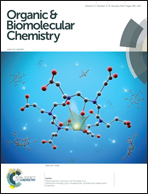Discovery of novel FabF ligands inspired by platensimycin by integrating structure-based design with diversity-oriented synthetic accessibility†
Abstract
An approach for designing bioactive small molecules has been developed in which de novo structure-based ligand design (SBLD) was focused on regions of chemical space accessible using a diversity-oriented synthetic approach. The approach was exploited in the design and synthesis of a focused library of platensimycin analogues in which the complex bridged ring system was replaced with a series of alternative ring systems. The affinity of the resulting compounds for the C163Q mutant of FabF was determined using a WaterLOGSY competition binding assay. Several compounds had significantly improved affinity for the protein relative to a reference ligand. The integration of synthetic accessibility with ligand design enabled focus to be placed on synthetically-accessible regions of chemical space that were relevant to the target protein under investigation.


 Please wait while we load your content...
Please wait while we load your content...